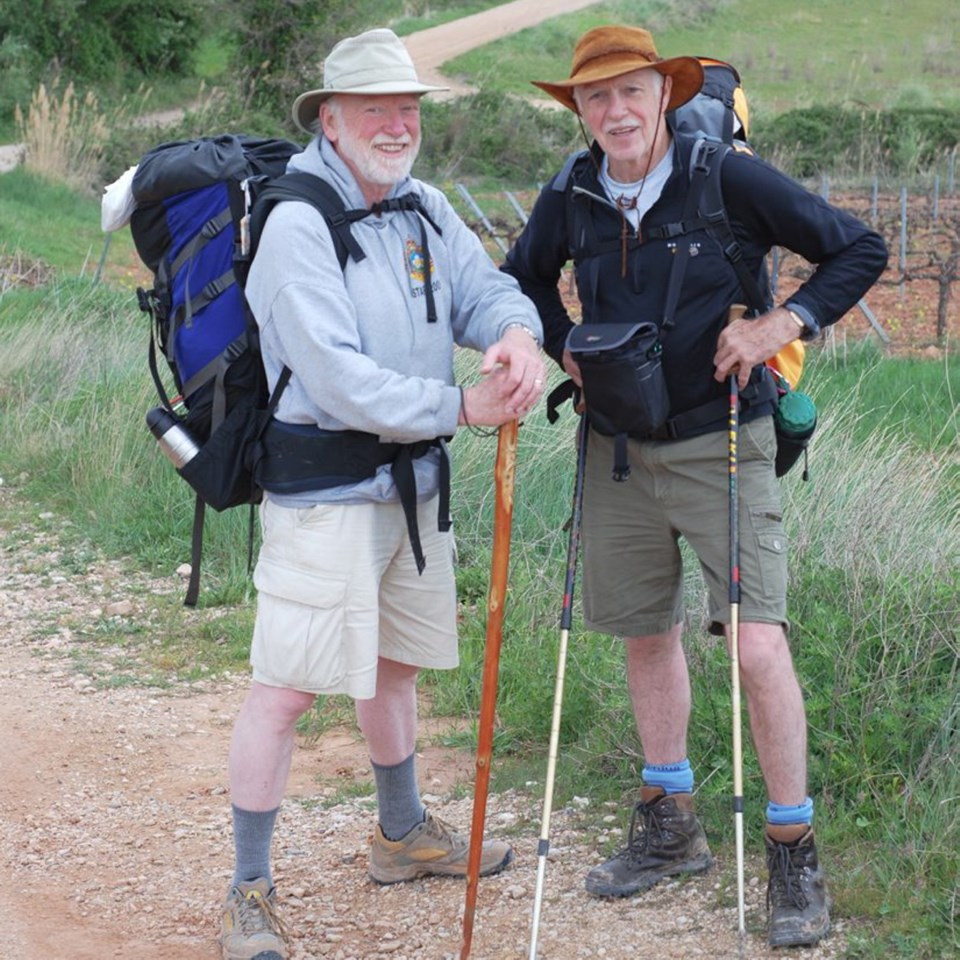What: Walking the Camino
Where: Cinecenta, UVic
When: Tonight-Sat., 7 and 9 p.m.; June 1-3, 7 and 8:45 p.m.
Info: 250-721-8365
Rating: Three stars (out of five)
When Wayne Emde returned to Santiago last year, it wasn’t as a pilgrim. He came back as a movie star.
“A guy came up to me and said, ‘Aren’t you the gentleman in that movie we saw last night?’ ” said the retired Vernon educator.
Walking the Camino: Six Ways to Santiago was screened in June at the Festival Cine Y TV Camino de Santiago, where it won best documentary for Portland, Ore., filmmaker Lydia B. Smith.
Emde and Kelowna-based friend Jack Greenhalgh, an Episcopal priest, didn’t realize they’d have company in the spring of 2009 when they walked the 800-kilometre ancient path from St. Jean Pied de Port in France across northern Spain to the cathedral in Santiago de Compostela, where St. James is believed to be entombed.
They knew they’d encounter many other international pilgrims journeying in the traditional manner, carrying backpacks and staying at albergues (pilgrim hostels).
What surprised them was being approached by a videographer as they climbed the Pyrenees, then being recruited as two of its featured pilgrims — “the old guys” —whose experiences were captured in the film screening at Cinecenta tonight through Saturday, with Emde and Greenhalgh in attendance.
Emde admits it was surreal returning to the scene of their life-changing journey.
One fan said fellow festivalgoers were convinced the film was scripted, and that he was a professional actor — an assumption he cheerfully dismissed.
“They just caught up with us every two or three days to interview us. It was all cold,” said Emde, who gets misty-eyed on camera as he reflects on the death of Joan, his wife of 37 years.
“It had been four years [since she died] and I thought I was doing OK,” he recalled. “But obviously I still had moments. It all came back suddenly.”
Returning to University of Victoria is particularly meaningful, says Emde, who completed his B.A. in English there in 1968, and received his teaching diploma a year later. He also worked on the construction of dorms next to the Student Union Building in the summer of 1968, and met Joan in 1966 there at a dance during Frosh Week.
Emde, who taught for 33 years, works as a part-time reporter with the Kelowna Daily Courier.
He embarked on his Camino adventure at the suggestion of his son, Jason, who had accompanied him on a 1,200-kilometre Buddhist pilgrimage in Japan the year before.
“For me the healing was a two-part thing,” he said. “ The Camino completed the circuit.”
Greenhalgh, senior padre at the Vernon Army Cadet Summer Training Centre when Emde, its public affairs officer, met him years ago, was an ideal traveling companion, he said. The former dean of St. Michael’s Cathedral in Kelowna had presided over Joan’s funeral.
“At the beginning we were a bit hesitant,” Emde admitted. “We kind of decided we weren’t going to let it get in the way, and they were really good about not forcing themselves on us.”
As schematic as it is picturesque, Walking the Camino preaches to the converted, a kind of inspirational travelogue that captures the allure and mystique of this ancient pilgrim route.
The pilgrims from different parts of the world Smith chiefly focuses on during their month-long journey include Annie, a competitive friend from Los Angeles; Tomas, a handsome Portugese adventurer; Misa, a Danish woman whose introspective journey is altered by her bond with William; Sam, a Brazilian woman seeking a more holistic way to overcome her clinical depression and a toxic relationship; and Tatiana, a religious French single mother who brings along her three-year-son.
Along the way, relationships form along with blisters and sore ankles and there are epiphanies and soul-searching.
It’s to Smith’s credit that in her testament to tenacity she acknowledges the reality beyond the romanticism — not just the foot pain, but snoring, flatulence, sweat and stink from wearing the same clothes day after day.
Offsetting the breathtaking backdrop — “It’s like walking in a postcard,’” one walker says — the film also captures the communal spirit that ensues, as when a scruffy stranger’s act of kindness reduces Annie to tears.
By the end of the film Smith has made it clear it’s the journey that counts most.
